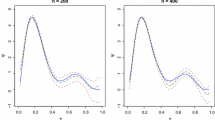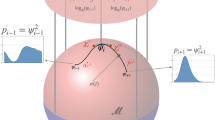Abstract
This paper proposes an adaptive density estimation procedure that hinges on securing moment-based approximants of certain splines passing through particular points that are obtained from an appropriately adjusted and truncated empirical distribution function. More specifically, a four-parameter beta density estimate is initially fitted to the data in order to determine the endpoints of the distribution which are combined to the data points. Interpolants of the continuity-corrected empirical distribution function evaluated at these points are then approximated by smooth functions involving polynomials. As a matter of course, the density estimates are obtained by differentiation. Any quantile of the corresponding distribution can thereby be directly evaluated from the associated distribution functions. The Cramér-von Mises goodness-of-fit statistic is utilized as a measure of accuracy. Three illustrative examples are presented.
















Similar content being viewed by others
References
Anderson TW (1962) On the distribution of the two-sample Cramér-von Mises criterion. Ann Math Stat 33(3):1148–1159
Devroye L, Gyorfi L (1985) Nonparametric density estimation: the L1 view (Wiley Series in Probability and Statistics). Wiley, New York
Eloyan A, Ghosh SK (2011) Smooth density estimation with moment constraints using mixture distributions. J Nonparametr Stat 23(2):513–531
Fritsch FN, Carlson RE (1980) Monotone piecewise cubic interpolation. SIAM J Numer Anal 17(2):238–246
Girard S, Guillou A, Stupfler G (2012) Estimating an endpoint with high-order moments. Test 21(4):697–729
Gramacki A (2019) Nonparametric density estimation and its computational aspects. Springer Nature, New York
Hall P (1982) On estimating the endpoint of a distribution. Ann Stat 11(1):556–568
Hall P, Wang JZ (1999) Estimating the end-point of a probability distribution using minimum-distance methods. Bernoulli 5(1):177–189
Hall P, Wang JZ (2005) Bayesian likelihood methods for estimating the end point of a distribution. J R Stat Soc Series B 67(5):717–729
Izenman AJ (1991) Recent developments in nonparametric density estimation. J Am Stat Assoc 86:205–224
Jiang M, Provost SB (2014) A hybrid bandwidth selection methodology for kernel density estimation. J Stat Comput Simul 84(3):614–627. https://doi.org/10.1080/00949655.2012.721366
Li D, Peng L, Qi Y (2011) Empirical likelihood confidence intervals for the endpoint of a distribution function. Test 20(2):353–366
Loh WY (1984) Estimating an endpoint of a distribution with resampling methods. Ann Stat 12(4):1543–1550
Liao JG, Wu Y, Lin Y (2010) Improving Sheather and Jones’ bandwidth selector for difficult densities in kernel density estimation. J Nonparametr Stat 22(1):105–114
Olkin I, Spiegelman CH (1987) A semiparametric approach to density estimation. J Am Stat Assoc 82:858–865
Provost SB (2005) Moment-based density approximants. Math J 9(4):727–756
Schuster E, Yakowitz S (1985) Parametric/nonparametric mixture density estimation with application to flood-frequency analysis. Water Resour Bull 21:797–804
Scott DW (1985) Average shifted histograms: effective nonparametric density estimators in several dimensions. Ann Stat 13:1024–1040
Silverman BW (1998) Density estimation for statistics and data analysis. Routledge, Boca Raton
Wang JZ (2005) A note on estimation in the four-parameter beta distribution. Commun Stat B Simul Comput 34(3):495–501
Waterman MS, Whiteman DE (1978) Estimation of probability densities by empirical density functions. Int J Math Educ Sci Technol 9(2):127–137
Zareamoghaddam H, Provost SB, Ahmed SE (2017) A moment-based bivariate density estimation methodology applicable to big data modeling. J Probab Stat Sci 15(2):135–152
Acknowledgements
The financial support of the Natural Sciences and Engineering Research Council of Canada is gratefully acknowledged. We also wish to thank the reviewers for their valuable comments and suggestions.
Author information
Authors and Affiliations
Corresponding author
Ethics declarations
Conflict of interest
None of the authors has any competing interests, financial or otherwise, which could be construed as being directly or indirectly related to this work.
Additional information
Publisher's Note
Springer Nature remains neutral with regard to jurisdictional claims in published maps and institutional affiliations.
Appendix:
Appendix:
1.1 The Fritsch-Carlson Monotonic Cubic Interpolation
Given a set of data points \(\left( x_{0}, f_{0}\right) ,\left( x_{1}, f_{1}\right) , \ldots ,\left( x_{p}, f_{p}\right)\) where \(x_0< \cdots < x_p\) and \(f_0< \cdots < f_p\), this approach relies on Hermite interpolation with the requirement that the derivatives at the knots be \(s_1 \tau _1,\, s_2 \tau _2, \ldots , s_p \tau _p\), where
and
with
the Hermite interpolation function on each interval \(\left[ x_{i}, x_{i+1}\right] , \ i=0,1, \ldots ,p-1,\) being
If one wishes readily to obtain some d.f. values or to determine certain quantiles on the basis of \(\{x_1,\ldots ,x_n\},\) a sample of n ordered observations, a Fritsch-Carlson third degree spline ought to provide reasonably accurate values throughout the support of the distribution once it is applied to the points
where \(\ell\) and u denote the estimated endpoints.
Rights and permissions
About this article
Cite this article
Provost, S.B., Yang, Z. & Ahmed, S.E. Securing Density Estimates via Smooth Moment-Based Empirical Distribution Function Approximants. J Indian Soc Probab Stat 23, 1–18 (2022). https://doi.org/10.1007/s41096-022-00119-4
Accepted:
Published:
Issue Date:
DOI: https://doi.org/10.1007/s41096-022-00119-4




